BUICK TERRAZA 2007 Repair Manual
Manufacturer: BUICK, Model Year: 2007, Model line: TERRAZA, Model: BUICK TERRAZA 2007Pages: 562, PDF Size: 2.96 MB
Page 61 of 562
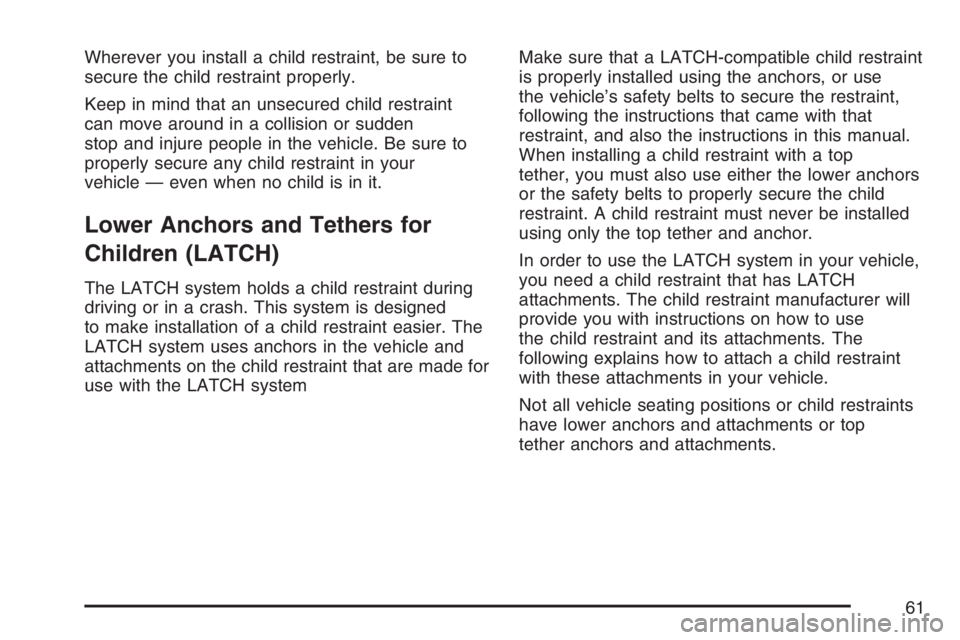
Wherever you install a child restraint, be sure to
secure the child restraint properly.
Keep in mind that an unsecured child restraint
can move around in a collision or sudden
stop and injure people in the vehicle. Be sure to
properly secure any child restraint in your
vehicle — even when no child is in it.
Lower Anchors and Tethers for
Children (LATCH)
The LATCH system holds a child restraint during
driving or in a crash. This system is designed
to make installation of a child restraint easier. The
LATCH system uses anchors in the vehicle and
attachments on the child restraint that are made for
use with the LATCH systemMake sure that a LATCH-compatible child restraint
is properly installed using the anchors, or use
the vehicle’s safety belts to secure the restraint,
following the instructions that came with that
restraint, and also the instructions in this manual.
When installing a child restraint with a top
tether, you must also use either the lower anchors
or the safety belts to properly secure the child
restraint. A child restraint must never be installed
using only the top tether and anchor.
In order to use the LATCH system in your vehicle,
you need a child restraint that has LATCH
attachments. The child restraint manufacturer will
provide you with instructions on how to use
the child restraint and its attachments. The
following explains how to attach a child restraint
with these attachments in your vehicle.
Not all vehicle seating positions or child restraints
have lower anchors and attachments or top
tether anchors and attachments.
61
Page 62 of 562

Lower Anchors
Lower anchors (A) are metal bars built into the
vehicle. There are two lower anchors for each
LATCH seating position that will accommodate a
child restraint with lower attachments (B).
Top Tether Anchor
A top tether (A, C) anchors the top of the child
restraint to the vehicle. A top tether anchor is built
into the vehicle. The top tether attachment (B)
on the child restraint connects to the top tether
anchor in the vehicle in order to reduce the forward
movement and rotation of the child restraint
during driving or in a crash.
Your child restraint may have a single tether (A) or
a dual tether (C). Either will have a single
attachment (B) to secure the top tether to the
anchor.
62
Page 63 of 562
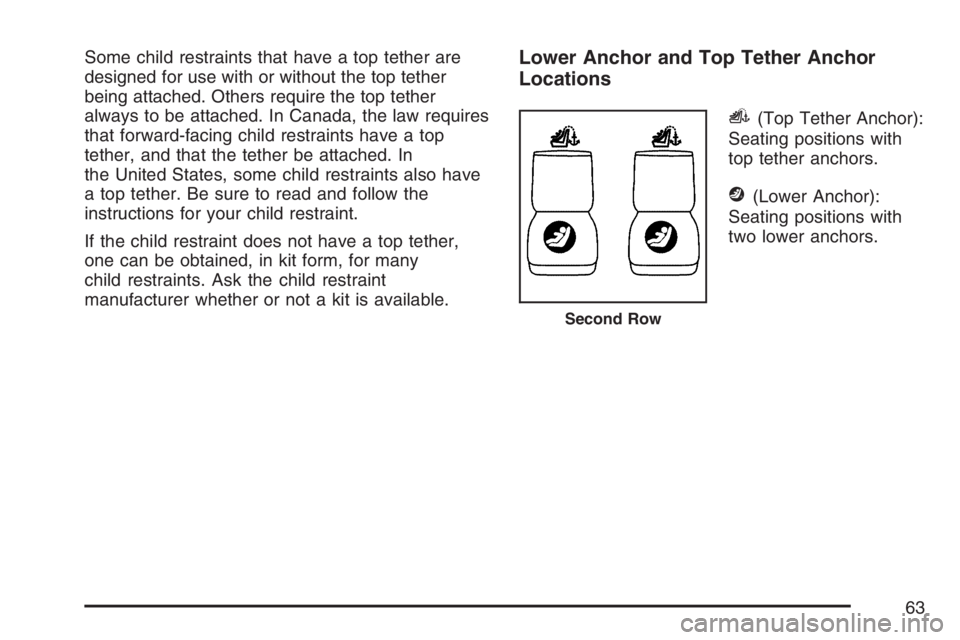
Some child restraints that have a top tether are
designed for use with or without the top tether
being attached. Others require the top tether
always to be attached. In Canada, the law requires
that forward-facing child restraints have a top
tether, and that the tether be attached. In
the United States, some child restraints also have
a top tether. Be sure to read and follow the
instructions for your child restraint.
If the child restraint does not have a top tether,
one can be obtained, in kit form, for many
child restraints. Ask the child restraint
manufacturer whether or not a kit is available.Lower Anchor and Top Tether Anchor
Locations
i(Top Tether Anchor):
Seating positions with
top tether anchors.
j(Lower Anchor):
Seating positions with
two lower anchors.
Second Row
63
Page 64 of 562
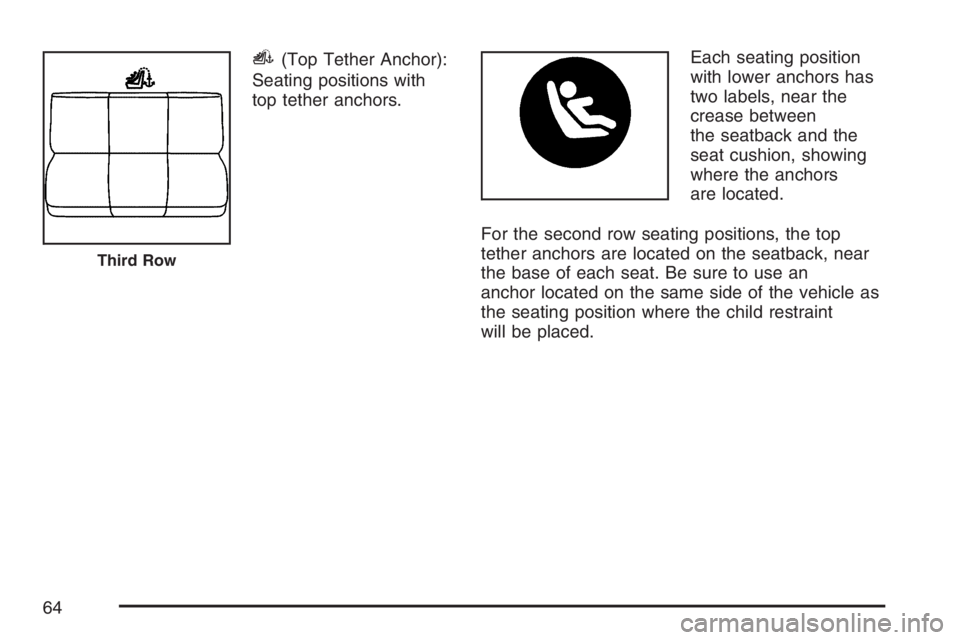
i(Top Tether Anchor):
Seating positions with
top tether anchors.Each seating position
with lower anchors has
two labels, near the
crease between
the seatback and the
seat cushion, showing
where the anchors
are located.
For the second row seating positions, the top
tether anchors are located on the seatback, near
the base of each seat. Be sure to use an
anchor located on the same side of the vehicle as
the seating position where the child restraint
will be placed.
Third Row
64
Page 65 of 562
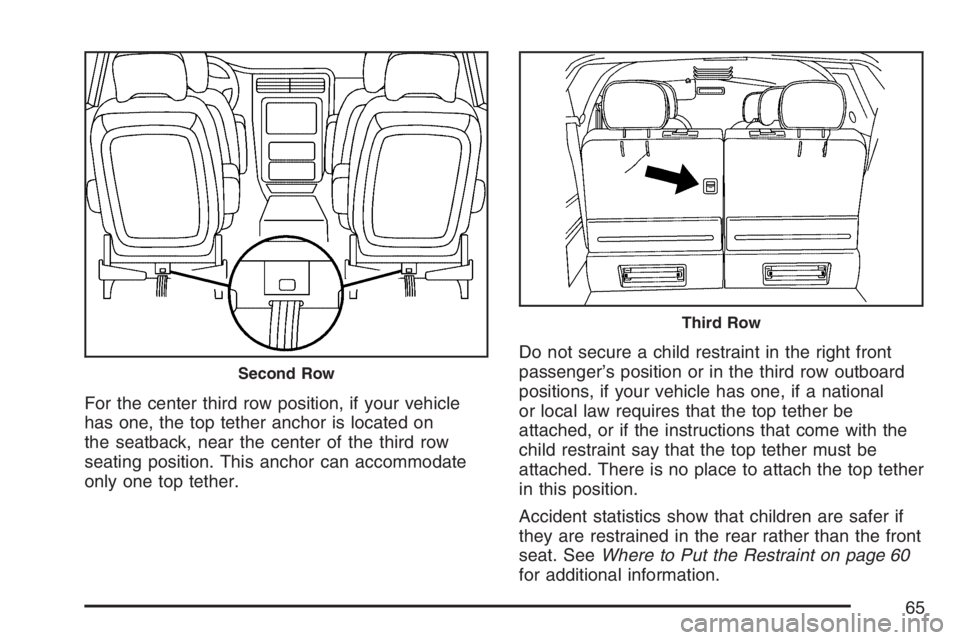
For the center third row position, if your vehicle
has one, the top tether anchor is located on
the seatback, near the center of the third row
seating position. This anchor can accommodate
only one top tether.Do not secure a child restraint in the right front
passenger’s position or in the third row outboard
positions, if your vehicle has one, if a national
or local law requires that the top tether be
attached, or if the instructions that come with the
child restraint say that the top tether must be
attached. There is no place to attach the top tether
in this position.
Accident statistics show that children are safer if
they are restrained in the rear rather than the front
seat. SeeWhere to Put the Restraint on page 60
for additional information.
Second Row
Third Row
65
Page 66 of 562
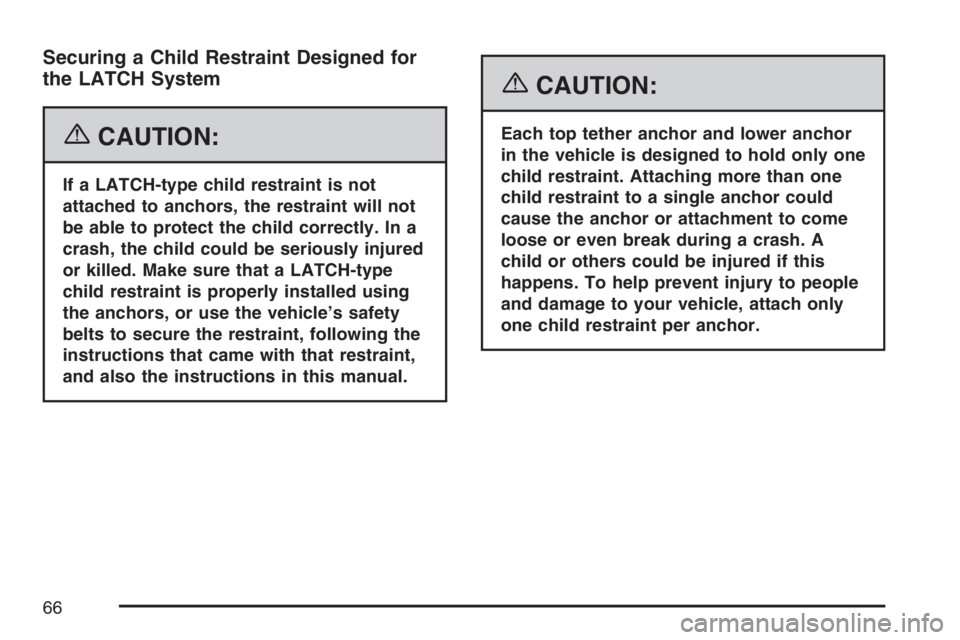
Securing a Child Restraint Designed for
the LATCH System
{CAUTION:
If a LATCH-type child restraint is not
attached to anchors, the restraint will not
be able to protect the child correctly. In a
crash, the child could be seriously injured
or killed. Make sure that a LATCH-type
child restraint is properly installed using
the anchors, or use the vehicle’s safety
belts to secure the restraint, following the
instructions that came with that restraint,
and also the instructions in this manual.
{CAUTION:
Each top tether anchor and lower anchor
in the vehicle is designed to hold only one
child restraint. Attaching more than one
child restraint to a single anchor could
cause the anchor or attachment to come
loose or even break during a crash. A
child or others could be injured if this
happens. To help prevent injury to people
and damage to your vehicle, attach only
one child restraint per anchor.
66
Page 67 of 562
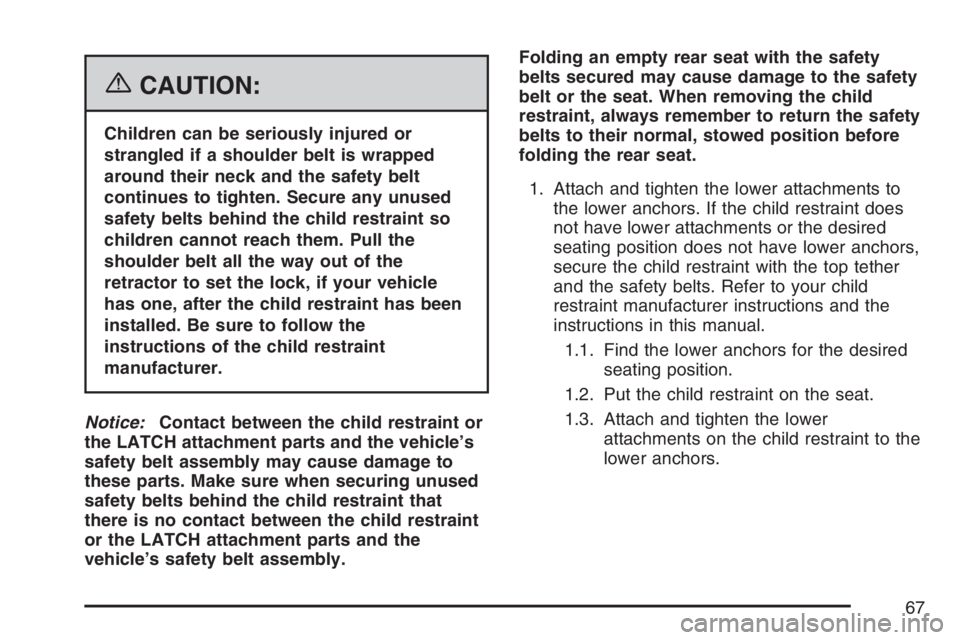
{CAUTION:
Children can be seriously injured or
strangled if a shoulder belt is wrapped
around their neck and the safety belt
continues to tighten. Secure any unused
safety belts behind the child restraint so
children cannot reach them. Pull the
shoulder belt all the way out of the
retractor to set the lock, if your vehicle
has one, after the child restraint has been
installed. Be sure to follow the
instructions of the child restraint
manufacturer.
Notice:Contact between the child restraint or
the LATCH attachment parts and the vehicle’s
safety belt assembly may cause damage to
these parts. Make sure when securing unused
safety belts behind the child restraint that
there is no contact between the child restraint
or the LATCH attachment parts and the
vehicle’s safety belt assembly.Folding an empty rear seat with the safety
belts secured may cause damage to the safety
belt or the seat. When removing the child
restraint, always remember to return the safety
belts to their normal, stowed position before
folding the rear seat.
1. Attach and tighten the lower attachments to
the lower anchors. If the child restraint does
not have lower attachments or the desired
seating position does not have lower anchors,
secure the child restraint with the top tether
and the safety belts. Refer to your child
restraint manufacturer instructions and the
instructions in this manual.
1.1. Find the lower anchors for the desired
seating position.
1.2. Put the child restraint on the seat.
1.3. Attach and tighten the lower
attachments on the child restraint to the
lower anchors.
67
Page 68 of 562
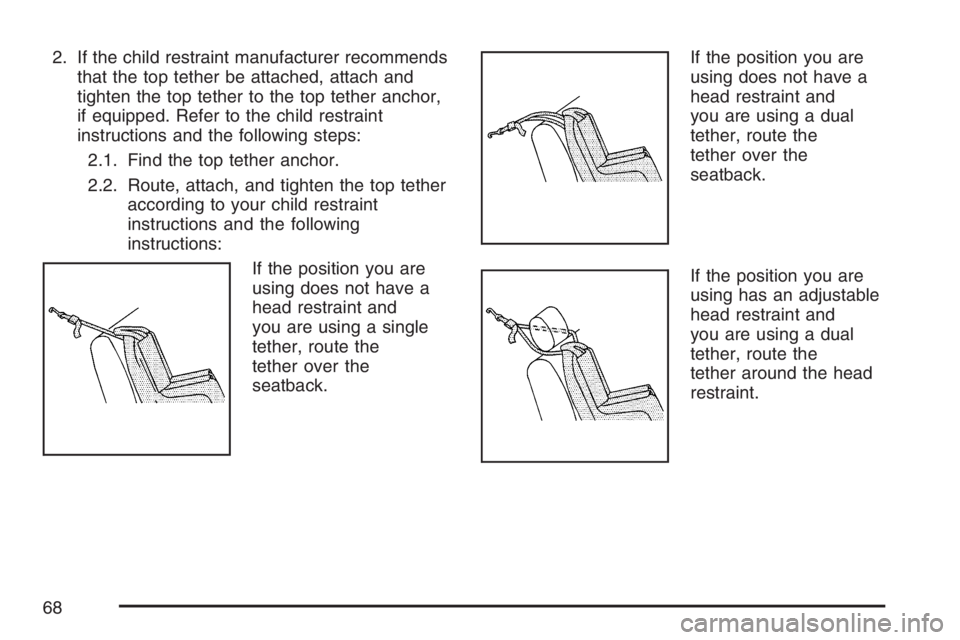
2. If the child restraint manufacturer recommends
that the top tether be attached, attach and
tighten the top tether to the top tether anchor,
if equipped. Refer to the child restraint
instructions and the following steps:
2.1. Find the top tether anchor.
2.2. Route, attach, and tighten the top tether
according to your child restraint
instructions and the following
instructions:
If the position you are
using does not have a
head restraint and
you are using a single
tether, route the
tether over the
seatback.If the position you are
using does not have a
head restraint and
you are using a dual
tether, route the
tether over the
seatback.
If the position you are
using has an adjustable
head restraint and
you are using a dual
tether, route the
tether around the head
restraint.
68
Page 69 of 562
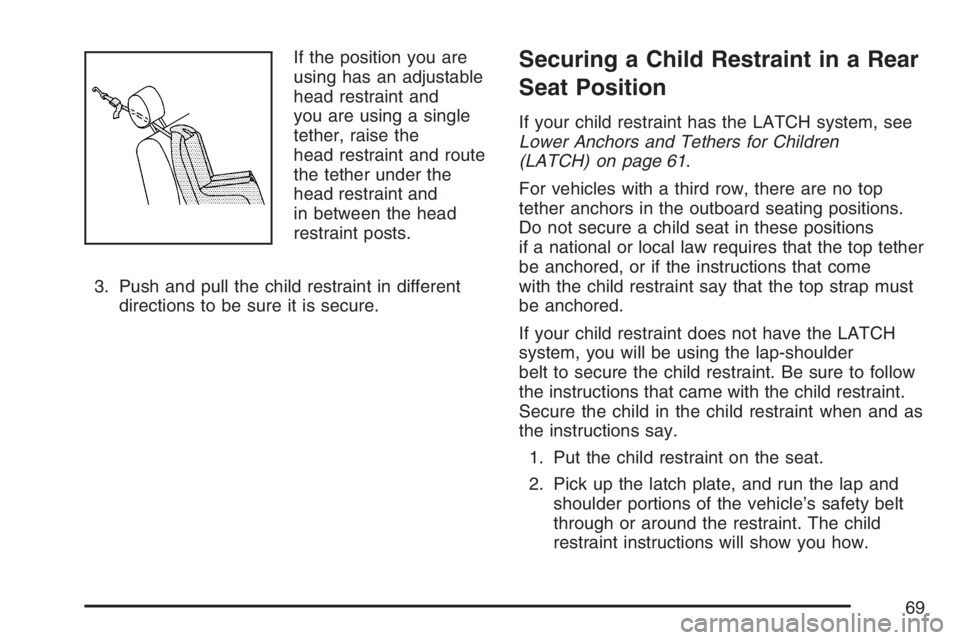
If the position you are
using has an adjustable
head restraint and
you are using a single
tether, raise the
head restraint and route
the tether under the
head restraint and
in between the head
restraint posts.
3. Push and pull the child restraint in different
directions to be sure it is secure.Securing a Child Restraint in a Rear
Seat Position
If your child restraint has the LATCH system, see
Lower Anchors and Tethers for Children
(LATCH) on page 61.
For vehicles with a third row, there are no top
tether anchors in the outboard seating positions.
Do not secure a child seat in these positions
if a national or local law requires that the top tether
be anchored, or if the instructions that come
with the child restraint say that the top strap must
be anchored.
If your child restraint does not have the LATCH
system, you will be using the lap-shoulder
belt to secure the child restraint. Be sure to follow
the instructions that came with the child restraint.
Secure the child in the child restraint when and as
the instructions say.
1. Put the child restraint on the seat.
2. Pick up the latch plate, and run the lap and
shoulder portions of the vehicle’s safety belt
through or around the restraint. The child
restraint instructions will show you how.
69
Page 70 of 562
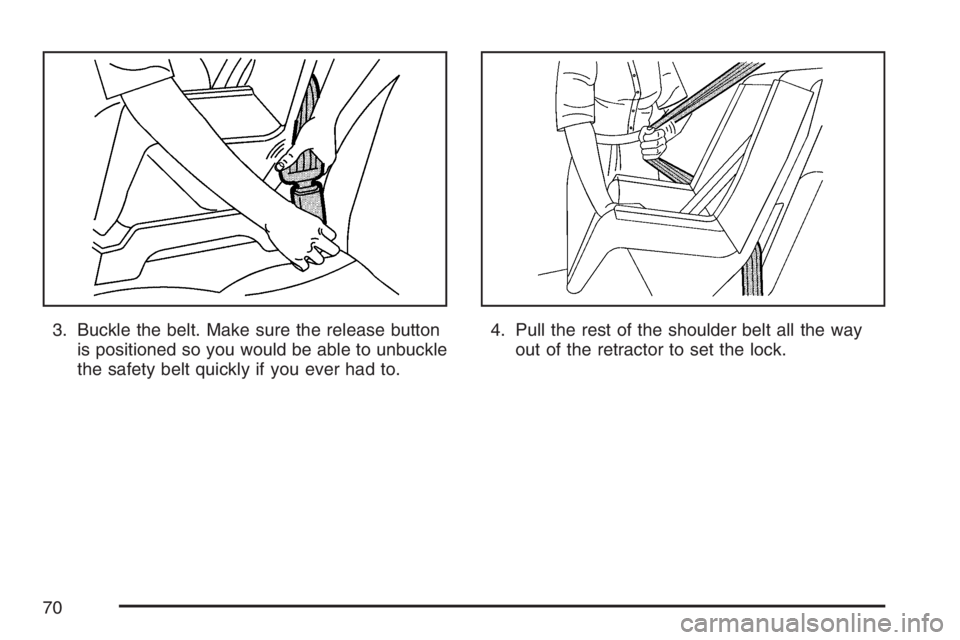
3. Buckle the belt. Make sure the release button
is positioned so you would be able to unbuckle
the safety belt quickly if you ever had to.4. Pull the rest of the shoulder belt all the way
out of the retractor to set the lock.
70